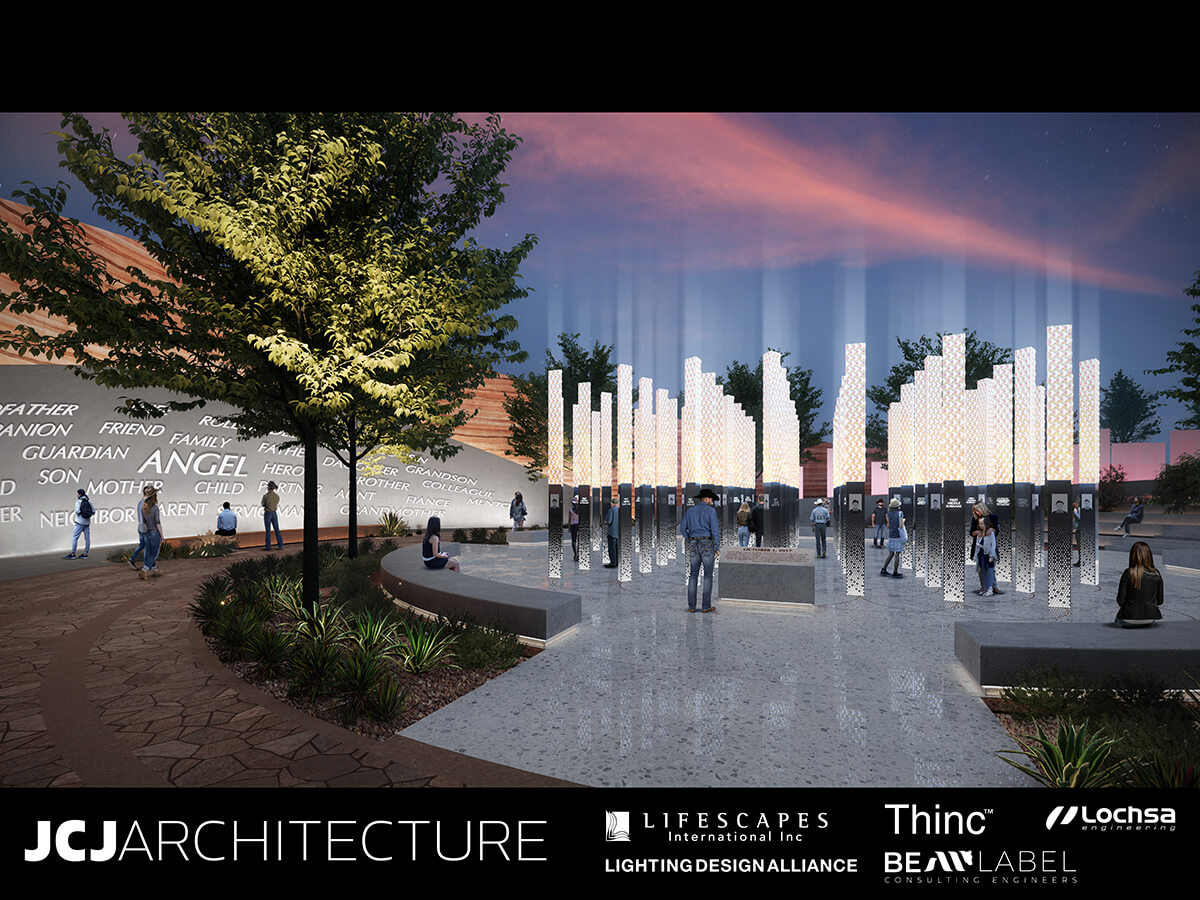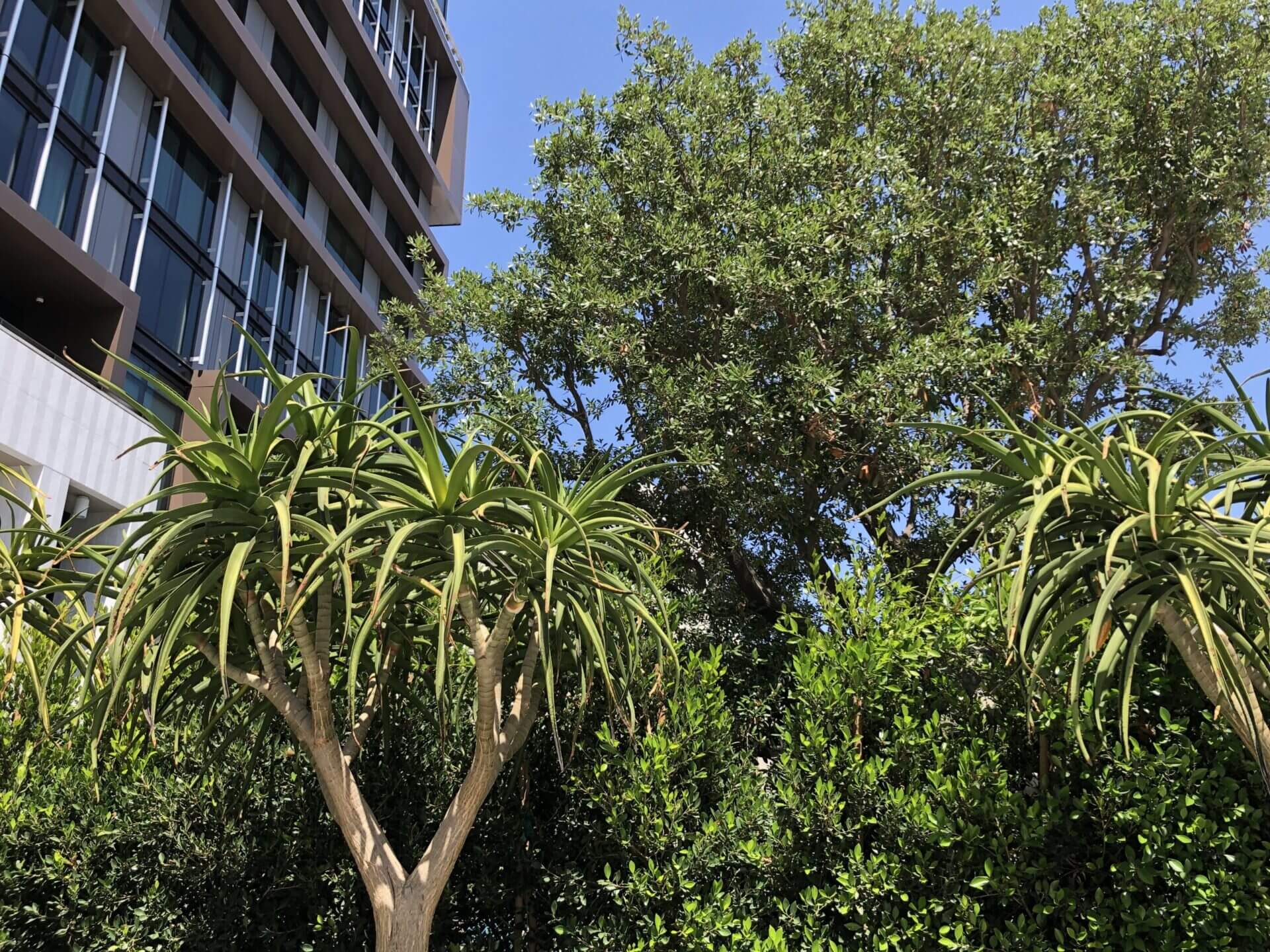The famous resort, The Mirage, on the Las Vegas Strip, is celebrating its 30 year anniversary!
The Mirage was the first new resort to be built in Las Vegas in 16 years, and the first mega-resort on the Las Vegas Strip (with a budget of $630M- an amount unheard of at that time), which launched the trend for future development along the Strip, and beyond. The core design team consisted of architect Joel Bergman, AIA; DeRuyter Butler, AIA; interior designer Roger Thomas, ![]() Peter Smith (all part of Atlandia Design, owned by Mirage Resorts at the time) and landscape architectural firm, Lifescapes International, with founders Don and Barbara Brinkerhoff, Roger Voettiner, Dan Trust, Andrew Kreft, and Julie Brinkerhoff-Jacobs. At the time of its opening, The Mirage was the largest hotel in the world, with 3,044 rooms.
Peter Smith (all part of Atlandia Design, owned by Mirage Resorts at the time) and landscape architectural firm, Lifescapes International, with founders Don and Barbara Brinkerhoff, Roger Voettiner, Dan Trust, Andrew Kreft, and Julie Brinkerhoff-Jacobs. At the time of its opening, The Mirage was the largest hotel in the world, with 3,044 rooms.
The way Lifescapes International was hired for the project was no less inspiring than the project itself. Upon meeting Steve Wynn in 1986, Lifescapes’ founder Don Brinkerhoff asked for a space to work and driving directions to an art supply store for materials. After a few hours, he presented a sketch and a scale model of the front of the hotel to Steve Wynn, and suggested positioning the volcano so that not only people traveling up and down The Strip, but also those at the porte cohere, would have the ability to experience the “show.” Steve Wynn immediately dismissed the other two firms, because he knew he had someone in front of him who would roll up his sleeves and work side by side with him to deliver his vision, “I want you to create an oasis in the middle of a dry, arid desert; and to also think of it this way… as a garden that happens to have a casino in it.”
The 100–acre site bordered by Caesars Palace on the south and Treasure Island on the north has 2,200 feet of frontage along the famous Las Vegas Blvd. The lush, tropical landscaping highlights a dramatic entrance which includes a lagoon with a five-story waterfall and volcano, which erupts 100’ into the air every evening. The design intent was to create something that didn’t look like it belonged in the middle of the Las Vegas desert; it was envisioned to be outside of a guest’s reality, illusionary, captivating and beyond one’s expectations – a fantasy. Hence the name- The Mirage.
What must this place look like on the inside? That’s how visitors strolling down The Strip must feel. From the exotic entrance, through the lush 90′ tall atrium with its palm tree canopy, babbling streams and pathways dotted with orchids, elephant ears, canary palms, banana trees, ferns and a plethora of greenery; guests are led to the restaurants, retail shops, show and casino area. Bamboo structures and thatched ceilings form a backdrop for marble paving, inset carpets and colorful rattan furnishings. Everything had to be accounted for, from the sun studies that allowed the team to control light so it didn’t spill haphazardly into the casino, to the heat, drying and humidity.
and pathways dotted with orchids, elephant ears, canary palms, banana trees, ferns and a plethora of greenery; guests are led to the restaurants, retail shops, show and casino area. Bamboo structures and thatched ceilings form a backdrop for marble paving, inset carpets and colorful rattan furnishings. Everything had to be accounted for, from the sun studies that allowed the team to control light so it didn’t spill haphazardly into the casino, to the heat, drying and humidity.
Lifescapes was challenged to create a believable paradise, beyond one’s expectations, on the Las Vegas Strip, which could overcome the harsh climate of extreme chills in the winter to dry sweltering heat in the summer, coupled with strong winds year-round.
Don Brinkerhoff says his design philosophy is ninety percent problem-solving and ten percent inspiration. Needing to convey a South Seas-inspired environment and knowing that coconut palms cannot grow in Vegas, Don found a solution by recalling travels to a palm grove in the south of Spain (with a similar climate to Nevada) where 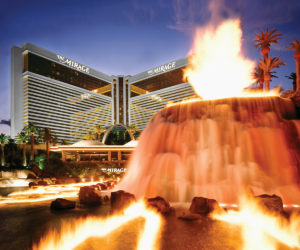 Moroccans had planted Canary Island date palms that could thrive in warmer climates. These became the signature trees at The Mirage.
Moroccans had planted Canary Island date palms that could thrive in warmer climates. These became the signature trees at The Mirage.
The mountain, which becomes a volcano at night, had to have a theatrical quality and be lit in such a way that the entire Las Vegas Blvd entrance garden would “sing at night.” New techniques for steam and gas ignition and effective lighting were tested again and again, then successfully integrated into the overall Mirage experience. The feature would be a 40’ high mountain waterfall during the day and an erupting, fire spewing volcano at night, enticing visitors to come in and explore the property.
The swimming pool area is a tropical paradise of tree-lined islands, waterfalls, grottos and lagoons. It had to “keep the promise” with the same intensity and level of believability, but on a more personal, human scale. The pool was divided into sequestered areas where small groups could gather, 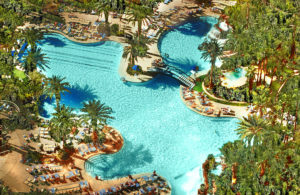 lay in the sun and socialize with one another. People in Vegas want to have space around them but be in the center of the action, so the landscaping would create natural privacy, but never seclusion from the greater environment. Private cabanas and umbrellas shade the bar stools at the Dolphin Bar and heighten the sense of being in a South Seas paradise.
lay in the sun and socialize with one another. People in Vegas want to have space around them but be in the center of the action, so the landscaping would create natural privacy, but never seclusion from the greater environment. Private cabanas and umbrellas shade the bar stools at the Dolphin Bar and heighten the sense of being in a South Seas paradise.
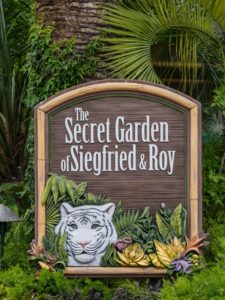
The landscape environment is rounded out with a myriad of habitats from the Dolphin Habitat to Siegfried and Roy’s Secret Garden (opened in 1990), with white tigers, panthers, elephants and other wildlife. At opening, there were four Atlantic Bottlenose Dolphins (many calves have been born since). Guests can admire the majestic animals while roaming the unique setting of the habitats 52 weeks a year.
The Mirage and its overwhelming success set the tone for future integrated resort development in Las Vegas, across the country and around the world. It also ignited the design trajectory of Lifescapes International domestically and globally. We went on to design more than 55 casino resorts around the world, 16 on the Las Vegas Strip, 10 hotels in the Las Vegas Metro Area, the Fremont Experience and 4-1/2 miles of streetscaping on the Nevada Scenic Hwy (Las Vegas Blvd) in 1996. We are forever appreciative of the opportunities and experiences it has given us to design hospitality, retail and other varieties of projects that endure and delight generations of guests here at home and worldwide… as we continue to Create Gardens People Love.SM

